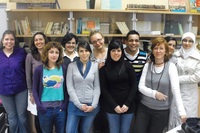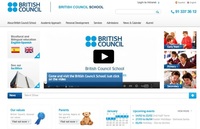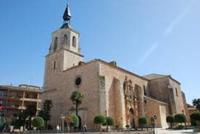Spain
Countries :: Spain
Article on Multilingual Education
Speaking up - announcing a multilingual revolution
Matthias Krug article for Abode Magazine
This article talks about Multilingual / Bilingual Education / CLIL in Spain and Qatar
Posted June 5th, 2010
CLIL Conference - Building Bridges
Important meeting of teachers in Madrid bringing language teachers and content teachers from schools in the Bilingual network of schools in Spain.British Council School, Madrid 02.02.13
CLIL Conference
The British Council School
Madrid
02.02.13
Building bridges between content and language
![/userfiles/files/spain-bridges-britschool2.jpg [/userfiles/files/spain-bridges-britschool2.jpg]](/userfiles/files/spain-bridges-britschool2.jpg)
The British Council School, Madrid
When I was asked to contribute to the recent event organized by the British Council in Madrid which came to be entitled 'Building bridges between content and language' little did I know that I'd be about to experience a revelation in pedagogical thinking, that I haven't felt in several years.
![/userfiles/files/spain-bridges1.jpg [/userfiles/files/spain-bridges1.jpg]](/userfiles/files/spain-bridges1.jpg)
setting up, people arriving
The title of the event came from a brainstorm between Mark Levy (Head, English and Schools at BC Spain), Phil Ball (ball.philip6@gmail.com), and myself. We had the initial working title 'things language teachers need to know about content and things content teachers need to know about language'. We'd met in a conference call to talk about potential participants all coming from schools in bilingual programmes in Spanish schools, the working title and what we might prepare given our backgrounds in CLIL.
![/userfiles/files/spain-bridges2.jpg [/userfiles/files/spain-bridges2.jpg]](/userfiles/files/spain-bridges2.jpg)
I kicked off the event
Fairly quickly we rejected a host of terms which we'd met before for CLIL meetings where groups of teachers were brought together, concluding that we didn't really see what the real-life meaning was of the terms in practice: CLIL Synergy was one title we rejected. Phil and I began to talk about scaffolding, a common term in CLIL given the relationship between supporting learning and this metaphor, which led us to construction and language in this field. It made a lot of sense to talk about 'bridges' between the worlds of language and content education since both subject areas are relevant entities in their own rights, and we wanted to avoid descriptions which focused on 'something missing' in either field. A bridge brings two sides together, and offers a shared medium for communication once its built - So 'Building bridges' it was. It worked in terms of pedagogical thinking AND in terms of interaction between the two areas.
![/userfiles/files/spain-bridges3.jpg [/userfiles/files/spain-bridges3.jpg]](/userfiles/files/spain-bridges3.jpg)
introductions and working in Plovdiv
We also fairly quickly decided how we would share the presentation time. Phil has a long recent history in writing resources for language teachers based on the content curriculum. You can find many examples of his work and the work of the (Ikastolas Schools in the Basque country) on the internet. There are links to two of their books here in FACTWorld.
Here, (take a look at the English in projects on the Eleanitz website) ground-breaking language teaching resources have been written for English language learners where the language and content come directly from an investigation and analysis of the content and language that is being taught in the content subject curriculum. I have highlighted directly above because this has to be stressed: the English language curriculum is based on what is being taught in the Geography, History classrooms. This kind of approach is very rare in my experience, and is both a 'left-field' approach to language education, to use a term Phil is fond of (he's right too), AND is an extremely sensible way of offering learners their foreign language curriculum.
![/userfiles/files/spain-bridges4.jpg [/userfiles/files/spain-bridges4.jpg]](/userfiles/files/spain-bridges4.jpg)
the room was packed out
The language they learn supports the content they learn and at the same time, the learners are 'doing something' while learning the language. The language lessons are sequenced conceptually as opposed to linguistically or thematically as they tend to be in ELT textbooks on sale on the market today. As Phil described in his talk, sudents of EFL are used to goin in one chapter from 'climate change' to 'Britney Spears' in the next while in Geography, they may look at 'The weather' in one unit, and move on from this to look at 'Agriculture' (and how this relates to weather patterns). With this background, it made sense that Phil talk about 'what content teaching can offer to language teachers'.
For my part, I've been involved in writing resources which 'make language salient' and these resources are largely written using ELT techniques and methods. VPS Science and Geography, Your CLIL (www.onestopenglish.com). In my work with subject teachers in a variety of contexts, most recently Technical High School teachers in Austria (HTL CLIL) I work at providing subject teachers with a 'tool box' of language teaching techniques and instruments that they can exploit in their work teaching their subjects through English. My job, then, was to talk about what language teaching can offer subject teachers, or as I subtitled it, 'what subject teachers might pinch from language teachers'.
![/userfiles/files/spain-bridges5.jpg [/userfiles/files/spain-bridges5.jpg]](/userfiles/files/spain-bridges5.jpg)
what English teachers do
I went first too. This made a lot of sense, as most of the audience, I think 70%, were language teachers. I spoke about two things that are important characteristics of the ELT tool box, first, identifying and highlighting language, and second, principles of task design. I won't describe the talk here, you can take a look at the presentations when they are uploaded to the British Council website. Suffice to say, language teachers are very good at 'making language salient', making it visible for learners and this technique is useful for content teachers to try to adopt, and language teachers have in their repertoire a vast array of activity types to draw on which I strongly encourage subject teachers to 'pinch' and adapt to their content teaching needs through English.
There were 250 teachers at the event, and I'd like to take my hat of to the British Council in Madrid, particularly to Mark Levy for his foresight in offering this event. Mark sees a clear need to bring these areas of teaching together in Spain (and abroad). In Spain, nearly all of the Communities now have bilingual programmes, and despite the devastating economic climate, it is testament to the success of CLIL that these programmes still exist and interest in them is still growing. Among job cuts, and general budget cutbacks in education in Spain one might expect CLIL to be an easy sector to get the chop (I do hope that I'm not speaking too soon!)
![/userfiles/files/spain-bridges6.jpg [/userfiles/files/spain-bridges6.jpg]](/userfiles/files/spain-bridges6.jpg)
things subject teachers do
... and the revelation I'd experienced in pedagogy, I can hear you asking.
It was this...
3 dimensions of CLIL - 3D CLIL, you heard it first here!!!
Effective content and language integration, whether it is 'English language teachers doing content' or 'content teachers teaching in English' depends on a 3D perspective of CLIL, let's call it 3D CLIL. These three perspectives, or dimensions are: concepts, procedures, and language. Phil talked about these three dimensions in his own very intelligent yet down-to-earth style. I think it also helped that he is fluent in Spanish, so he could pepper his wit and insight with 'hacemos cosas', for example, while explaining that the content curriculum offers 'something to do' to language teachers in a content desert.
![/userfiles/files/spain-bridges7.jpg [/userfiles/files/spain-bridges7.jpg]](/userfiles/files/spain-bridges7.jpg)
Mark does the raffle, many thanks to Eleanitz and Macmillan for the freebies!
Phil also brought this consideration of CLIL as three-dimensional down to making teaching objectives both 'transparent' and 'specific' and that when content teachers have an object, they tend to 'front' the concepts with some attention to procedures and when language teachers write objectives, they are interested primarily in the language with some attention to procedures. What we need is a CLIL that gives objectives to teaching with a focus on all three: concepts, procedures and language.
![/userfiles/files/spain-bridges8.jpg [/userfiles/files/spain-bridges8.jpg]](/userfiles/files/spain-bridges8.jpg)
questions and closing
![/userfiles/files/spain-bridges9.jpg [/userfiles/files/spain-bridges9.jpg]](/userfiles/files/spain-bridges9.jpg)
Me, Mark and Phil
I know Phil is writing about 3D CLIL. I know because I'm lending a hand, and so is John Clegg.
Watch this space for more on 3D CLIL!
04.02.13
The Bilingual Project
CLIL teacher training, Daimiel, Spain, 26-29th Oct 2004
A two and half day workshop for English-medium teachers of Geography, History, Science was carried out in the central Spanish town of Daimiel this week coordinated by the British Council through Teresa Reilly (teresa.reilly@britishcouncil.es), in collaboration with the Spanish Ministry of Education and teachers on the Bilingual Project in Spain.
![/userfiles/files/spain-biproj1.jpg [/userfiles/files/spain-biproj1.jpg]](/userfiles/files/spain-biproj1.jpg)
Getting started in Diamiel…
![/userfiles/files/spain-biproj2.jpg [/userfiles/files/spain-biproj2.jpg]](/userfiles/files/spain-biproj2.jpg)
Phil Ball, and Pilar from the Ministry of Education
40 teachers from 17 schools around Spain attended two days of workshops based on a number of themes related to the teaching of Science and Social Sciences through the medium of English and the workshops were delivered by myself and my colleague, Phil Ball (szpbabap@sc.ehu.es), an education consultant with a great deal of experience with teachers working through the medium of a foreign language in the Basque Country.
![/userfiles/files/spain-biproj3.jpg [/userfiles/files/spain-biproj3.jpg]](/userfiles/files/spain-biproj3.jpg)
Colleagues discuss coordination…
This initiative is being carried out during a transition stage of an existing project moving from primary to secondary education. The Bilingual Project began in 1996 and the first children are now studying in secondary schools. We worked with the teachers from these schools who have received the first wave of children from the orginal project.
![/userfiles/files/spain-biproj4.jpg [/userfiles/files/spain-biproj4.jpg]](/userfiles/files/spain-biproj4.jpg)
Teachers doing practical work…
Outcomes from the two and a half days included:Coordination – colleagues agreed specific Action Plans for the future of their work in the project.Materials – The British Council has provided sets of Hodder Gold Science for each of the schools and Phil and I are putting together a booklist for the subjects being taught and copies will be placed in British Council resource centres in Spain. Additionally, the colleagues will be creating their own materials to suit the very specific needs of the children they are teaching.Webspace – the Ministry of Education has provided a web forum for the teachers on the project where they will be able to discuss issues and share materials. Maria from the Balleares has agreed to help coordinate this group. Thanks Maria!Follow up – Colleagues were offered the chance to sign up free of charge to Science Across the World (www.scienceacross.org) and make the most of opportunities for exchange with 2500 schools around the world. The teachers will also be joining the Forum for Across the Curriculum Teaching yahoogroup (www.yahoogroups.com factworld) and sharing with the 1300 teachers in our network in 40 countries around the world.
![/userfiles/files/spain-biproj5.jpg [/userfiles/files/spain-biproj5.jpg]](/userfiles/files/spain-biproj5.jpg)
Bilingual rocket launching…
I have to say that I find the work in Spain an encouraging and astonishing example of a large scale project integrating the learning of content and language. There is a lot of challenging work for these colleagues to do as their students make their way through the secondary curriculum in the English language. The enthusiasm of these teachers is perhaps down to the wonderful children they have been asked to work with. Sebastian, a Science teacher, summed it all up when he said, ‘it’s amazing, these children are learning science through English. I can teach them my subject entirely in English.’I hope to stay in touch with these colleagues and be involved in their exciting work. Would love to be a fly on the wall in one of Sebastian’s lessons!


